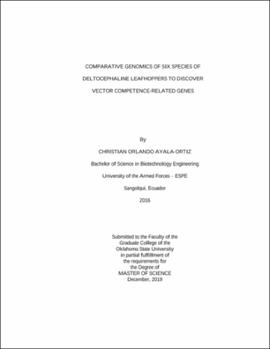| dc.contributor.advisor | Wayadande, Astri | |
| dc.contributor.author | Ayala-Ortiz, Christian Orlando | |
| dc.date.accessioned | 2020-06-03T19:04:41Z | |
| dc.date.available | 2020-06-03T19:04:41Z | |
| dc.date.issued | 2019-12 | |
| dc.identifier.uri | https://hdl.handle.net/11244/324818 | |
| dc.description.abstract | Insects have been widely used in genomics research and reference genomes and transcriptomes are available for several model species. However, for non-model organisms, such as leafhoppers, this kind of information is still lacking. The Deltocephalinae (Hemiptera: Cicadellidae), is a leafhopper subfamily that comprises several vectors of economically important plant pathogens, as well as non-vector species. The ability of some species to acquire and transmit a pathogen is called vector competence. Since genomics studies can lead to insight into the mechanisms underlying biological processes, comparisons between the genomes and transcriptomes of vector and non-vector leafhoppers can lead to a better understanding of the genes involved in vector competence. However, identifying those genes is not enough to understand their function. Functional studies, involving the mutation or silencing of those genes are required to fully understand the biological processes in which they are involved. During this study the draft genomes and transcriptomes of six species of Deltocephaline leafhoppers, four vectors and two non-vectors, were sequenced, annotated and compared looking to discover vector-competence related genes. Draft genomes were assembled using MEGAHIT and transcriptomes were assembled using Trinity. The resulting draft genomes had sizes between 0.85 and 1 Gbp and completeness ranging from 53% to 77% according to the Arthropoda BUSCO genes. Genomes were annotated using PASA and transcriptomes were annotated using the Trinotate pipeline. A clustering analysis of the peptide sequences obtained from the transcriptomes identified actin, ATP synthase, vinculin, paramyosin and other genes as possible candidate genes involved in vector competence and insect vector transmission. Furthermore, the use of RNAi as a tool to study gene function was demonstrated by knocking down the laccase-1 gene of Dalbulus maidis. Third instar nymphs of D. maidis were fed 50 uL of laccase-1 dsRNA for six consecutive days. A reduction in the relative expression of the laccase-1 transcript was observed at day 4 and 6. However, because none of the insects survived and developed into adults, more analyses are required to confirm the RNAi silencing of this gene. | |
| dc.format | application/pdf | |
| dc.language | en_US | |
| dc.rights | Copyright is held by the author who has granted the Oklahoma State University Library the non-exclusive right to share this material in its institutional repository. Contact Digital Library Services at lib-dls@okstate.edu or 405-744-9161 for the permission policy on the use, reproduction or distribution of this material. | |
| dc.title | Comparative genomics of six species of Deltocephaline leafhoppers to discover vector competence-related genes | |
| dc.contributor.committeeMember | Blagden, Trenna | |
| dc.contributor.committeeMember | Marek, Stephen | |
| osu.filename | AyalaOrtiz_okstate_0664M_16546.pdf | |
| osu.accesstype | Open Access | |
| dc.type.genre | Thesis | |
| dc.type.material | Text | |
| dc.subject.keywords | deltocephalinae | |
| dc.subject.keywords | genome | |
| dc.subject.keywords | rnai | |
| dc.subject.keywords | transcriptome | |
| dc.subject.keywords | vector competence | |
| thesis.degree.discipline | Entomology and Plant Pathology | |
| thesis.degree.grantor | Oklahoma State University | |
